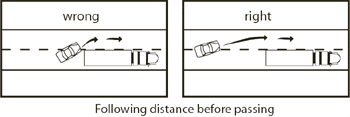Call Us: 1-888-272-1493 Live Chat
Powered by American Safety Council
Call Us: 1-888-272-1493 Live Chat
Powered by American Safety Council
This section of the Florida Driver Handbook covers Speed Limits on Florida highways, the Florida Turnpike, Interstates, and other roads.
Topics included in this section of the Florida Driver Handbook include:
Speed causes many crashes. More drivers are convicted of speeding than any other offense. To avoid being fined or involved in a crash, obey the speed limits.
Speed is very important in a collision. If you double the speed of a car, you increase its force of impact four times. If you triple the speed, the impact is nine times as great.
70 Does Not Always Mean 70
Remember that speed limits show the fastest speed you may drive under good conditions. You are responsible for adjusting your driving speed to the road conditions. For example, if the weather is bad or there is a lot of traffic, you must drive more slowly than the posted speed. The safe speed is the one that allows you to have complete control of your vehicle.
Florida "Standard" Speed Limits
*The 55 MPH maximum speed limit is still in effect in Florida except where otherwise posted. *Speed limits are 70 MPH on some rural interstate highways. Speed limits may be changed on other multi-lane highways and in areas where the conditions require lower speeds. Drivers should not assume because the area appears to be a particular urban, municipality, business or highway area that the speed is the standard or expected speed zone. Observe and obey the posted speed signs as there may be frequent changes from area to area along the selected roads or highways.
Driving Too Slowly is also Against the Law
Drive with the flow of traffic (within the speed limit). You should not drive so slowly that you block other vehicles moving at normal, safe speeds. You can be issued a ticket for driving too slowly. When the posted speed limit is 70 mph, the minimum speed limit is 50 mph.
Following Officer's and Fireman's Instructions
If you are stopped by a law enforcement officer, pull off immediately to the extreme right, clear of traffic when possible. Turn off your engine. Reduce your headlights to the parking light position at night. Sit calmly and follow the instructions of the officer. You must follow any lawful order or direction of (1) any law enforcement officer or (2) any fireman at the scene of a fire who is directing traffic. If a law enforcement officer is directing traffic where there are signal lights, obey the officer — not the signals.
Crossing Intersections
More crashes happen at intersections than any other place. Be very careful when approaching any intersection or driveway.
If you are stopped, look for bicyclists and pedestrians who may be crossing the intersection from either direction.
Stay a safe distance behind the vehicle you want to pass. The closer you get to the vehicle you want to pass, the less you can see ahead. This is especially true when passing trucks, trailers, and other large vehicles. Before you pull out to pass, check your blind spots and make sure that you have plenty of time and room to pass.

On a two-lane road, tap your horn, or at night blink your headlights to let the other driver know you are passing.
![]()
Being Passed
When You May Not Pass
You may not pass on a two-lane road with traffic moving in opposite directions under these conditions:

Violators may be arrested or issued a ticket.
Minimum Safe Following Distances
Leave plenty of space between you and the car ahead. If it stops quickly, you will need time to see the danger and stop.
Using the Two-Second Rule
At any speed, you can use the two-second rule to see if you are far enough behind the car in front of you:
The two-second rule applies to any speed in good weather and road conditions. If road or weather conditions are not good, double your following distance. You should also double your following distance when driving a motor home or towing a trailer.
Following Distance For Trucks
A truck or any vehicle towing another vehicle may not follow within 300 feet of another truck or vehicle towing a vehicle. This law does not apply to overtaking and passing, and it does not apply within cities or towns.
Expressways — also called interstate highways, freeways, and turnpikes are multiple-lane roads with no stop signs, traffic lights, or railroad crossings. For these reasons, expressways can give you a fast, safe way to get where you need to go.
Pedestrians, hitchhikers, bicycles, animal-drawn vehicles or motor-driven cycles and motor scooters with 150 cubic centimeter displacement or less are not allowed on expressways.
Entering and Leaving Expressways
Vehicles can enter and leave expressways only at certain points. Because expressway traffic is usually moving at or close to the maximum speed allowed, you need to know how to enter and exit safely.
All expressway entrances have three basic parts: an entrance ramp, an acceleration lane, and a merging area. Follow these guidelines to enter an expressway safely:
When leaving an expressway:
Expressway Safety Reminders
Night Driving

You will need to drive with extra care at night. You cannot see as far ahead or to the side, and glare from oncoming cars can reduce your vision even more. Follow these guidelines for driving at night: